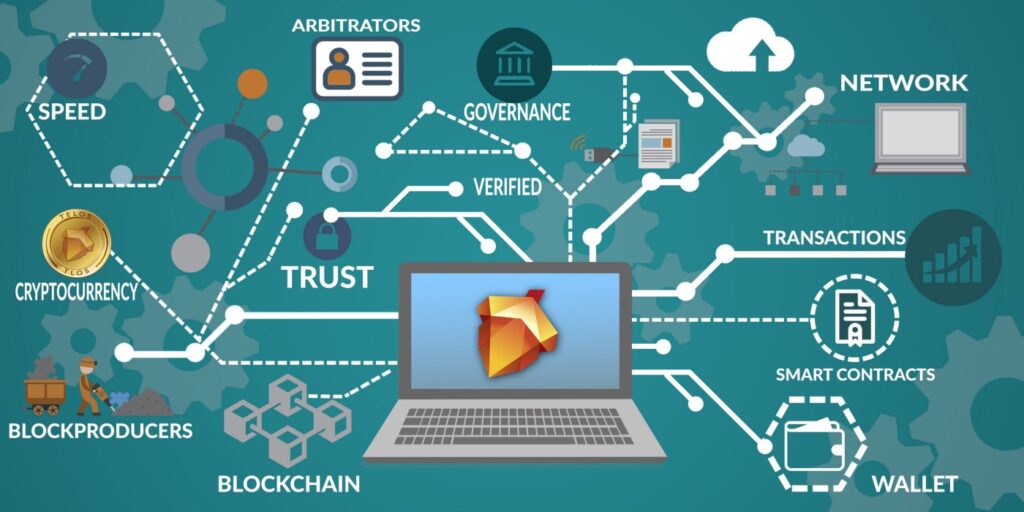How Blockchain Is Detailed In [year]: Blockchains are best known for their crucial role in cryptocurrency systems, such as Bitcoin, for maintaining a secure and decentralized record of transactions.
What is Blockchain?

Blockchain is a system of recording information in a way that makes it difficult or impossible to change, hack, or cheat the system.
How Blockchain Is Detailed In [year]: A blockchain is essentially a digital ledger of transactions that is duplicated and distributed across the entire network of computer systems on the blockchain. Each block in the chain contains a number of transactions, and every time a new transaction occurs on the blockchain, a record of that transaction is added to every participant’s ledger.
The decentralized database managed by multiple participants is known as Distributed Ledger Technology (DLT). Blockchain is a type of DLT in which transactions are recorded with an immutable cryptographic signature called a hash.

Definition of Blockchain
A blockchain is “a distributed database that maintains a continuously growing list of ordered records, called blocks.” These blocks “are linked using cryptography. Each block contains a cryptographic hash of the previous block, a timestamp, and transaction data.
A blockchain is a decentralized, distributed, and public digital ledger that is used to record transactions across many computers so that the record cannot be altered retroactively without the alteration of all subsequent blocks and the consensus of the network.”
While blockchain is still largely confined to use in recording and storing transactions for cryptocurrencies such as Bitcoin, proponents of blockchain technology are developing and testing other uses for blockchain.

Components of Blockchain Is Detailed in [year]
Blockchain for payment processing and money transfers
Transactions processed over a blockchain could be settled within a matter of seconds and reduce (or eliminate) banking transfer fees.
Blockchain for monitoring supply chains
Using blockchain, businesses could pinpoint inefficiencies within their supply chains quickly, as well as locate items in real-time, and see how products perform from a quality-control perspective as they travel from manufacturers to retailers.
Blockchain for digital IDs
Microsoft is experimenting with blockchain technology to help people control their digital identities, while also giving users control over who accesses that data.

Blockchain for data sharing
Blockchain could act as an intermediary to securely store and move enterprise data among industries.
Blockchain for copyright and royalties protection
Blockchain could be used to create a decentralized database that ensures artists maintain their music rights and provides transparent and real-time royalty distributions to musicians. Blockchain could also do the same for open-source developers.
Blockchain for the Internet of Things network management
Blockchain could become a regulator of IoT networks to “identify devices connected to a wireless network, monitor the activity of those devices, and determine how trustworthy those devices are” and to “automatically assess the trustworthiness of new devices being added to the network, such as cars and smartphones.”
Blockchain for healthcare
Blockchain could also play an important role in healthcare: “Healthcare payers and providers are using blockchain to manage clinical trial data and electronic medical records while maintaining regulatory compliance.”

Features of Blockchain In [year]
- Almost all cryptocurrencies, including Bitcoin, Ethereum, Bitcoin Cash, and Litecoin, are secured via blockchain networks. This means their accuracy is constantly being verified by a huge amount of computing power.
- The list of transactions contained in the blockchain is fundamental for most cryptocurrencies because it enables secure payments to be made between people who don’t know each other without having to go through a third-party verifier like a bank.
- Due to the cryptographic nature of these networks, payments via blockchain can be more secure than standard debit/credit card transactions. When making a Bitcoin payment, for instance, you don’t need to provide any sensitive information. That means there is almost zero risk of your financial information being compromised, or your identity being stolen.
- Blockchain technology is also exciting because it has many uses beyond cryptocurrency. Blockchains are being used to explore medical research, improve the accuracy of healthcare records, streamline supply chains, and so much more.

Business Benefits of Blockchain in [year]
The primary benefit of blockchain is as a database for recording transactions, but its benefits extend far beyond those of a traditional database. Most notably, it removes the possibility of tampering by a malicious actor, as well as providing these business benefits:
Time savings
Blockchain slashes transaction times from days to minutes. Transaction settlement is faster because it doesn’t require verification by a central authority.
Cost savings
Transactions need less oversight. Participants can exchange items of value directly. Blockchain eliminates duplication of effort because participants have access to a shared ledger.
Tighter security
Blockchain’s security features protect against tampering, fraud, and cybercrime.

The key concepts behind blockchain in [year] are:
A shared ledger is an “append-only” distributed system of records shared across a business network. “With a shared ledger, transactions are recorded only once, eliminating the duplication of effort that’s typical of traditional business networks.”
Permissions
Permissions ensure that transactions are secure, authenticated, and verifiable. “With the ability to constrain network participation, organizations can more easily comply with data protection regulations, such as those stipulated in the Health Insurance Portability and Accountability Act” and the EU General Data Protection Regulation.
Smart contracts
A smart contract is “an agreement or set of rules that govern a business transaction; it’s stored on the blockchain and is executed automatically as part of a transaction.”
Consensus
Through consensus, all parties agree to the network-verified transaction. Blockchains have various consensus mechanisms, including proof of stake, multisignature, and Practical Byzantine Fault Tolerance.

Advantages And Disadvantages Of Blockchains In [year]
Advantages Of Blockchains In [year]
A blockchain is a network of decentralized and distributed data, meaning the users share the ownership and management of the network through computer nodes. As a database, blockchain stores information in a digital format.
Decentralization
This is the main feature of blockchain technology, and the strong point is that to authenticate transactions or operations no other instance is required to act as an intermediary, reducing transaction validation times.
Network distribution
This point provides, at the same time, several benefits since, by having this network distributed, in the first instance, no one owns the network, allowing different users to always have multiple copies of the same information.
Low costs for users
The decentralized nature of Blockchain allows for the validation of person-to-person transactions quickly and securely. Eliminating the need for an intermediary reduces costs for users.

8 Quick Advantages of Blockchain
- Blockchain is DECENTRALIZED
- Blockchain ENABLES TOKENIZATION
- Blockchain is DEMOCRATIZING
- Blockchain is FAST
- Blockchain is COST-EFFECTIVE
- Blockchain is ENERGY EFFICIENT
- Blockchain ENGENDERS TRUST
- Blockchain is TRANSPARENT
Disadvantages Of Blockchains In [year]
High implementation costs
Just as this technology represents low costs for users, unfortunately, it also implies high implementation costs for companies, which delays its mass adoption and implementation.

Inefficiency
It is inefficient to have several network users validate the same operations since only one will receive the reward derived from this mining process. This process, and for the same reason of many users doing the same thing, also implies a huge waste of energy, and not very environmentally friendly technology.
Private keys
Excessive security can also be an Achilles heel, in the case of private keys, as has been documented on many occasions, having lost them it becomes almost impossible to recover these keys, causing a problem, mainly, for all those holders of cryptographic values.
Storage
As the number of users grows, the number of operations that will be integrated into the blocks to be stored will also grow, so the space required will also have to increase inside the miners’ computers, eventually exceeding the capacity of the hard disks.
Unemployment
The lack of need for intermediaries will cause that, as Blockchain technology is adopted and implemented, all these intermediation sectors for the validation of payments and processes will necessarily be reduced to the point of disappearing and, with it, the jobs required for it will disappear.

Types Of Blockchains In [year]
Public, private, hybrid, or consortium, each blockchain network has distinct pluses and minuses that largely drive its ideal uses — and will determine which one is best for you.
Public blockchain
The first type of blockchain technology is a public blockchain. This is where cryptocurrencies like Bitcoin originated and helped to popularize distributed ledger technology (DLT). It removes the problems that come with centralization, including less security and transparency. DLT doesn’t store information in any one place, instead distributing it across a peer-to-peer network. Its decentralized nature requires some method for verifying the authenticity of data.
Private blockchain
A blockchain network that works in a restrictive environment like a closed network, or that is under the control of a single entity, is a private blockchain. While it operates like a public blockchain network in the sense that it uses peer-to-peer connections and decentralization, this type of blockchain is on a much smaller scale.
Hybrid blockchain
Sometimes, organizations will want the best of both worlds, and they’ll use hybrid blockchain, a type of blockchain technology that combines elements of both private and public blockchain. It lets organizations set up a private, permission-based system alongside a public permissionless system, allowing them to control who can access specific data stored in the blockchain, and what data will be opened up publicly.

Consortium blockchain
The fourth type of blockchain, consortium blockchain, also known as a federated blockchain, is similar to a hybrid blockchain in that it has private and public blockchain features. But it’s different in that multiple organizational members collaborate on a decentralized network. Essentially, a consortium blockchain is a private blockchain with limited access to a particular group, eliminating the risks that come with just one entity controlling the network on a private blockchain.
4 Main Types of Blockchains In [year]
| Advantages | Disadvantages | Uses | |
| Public | Independence, Transparency, Trust | Performance, Scalability, Security | Cryptocurrency, Document Validation |
| Private | Access Control, Performance | Trust, Auditability | Supply Chain, Asset Ownership |
| Hybrid | Access Control, Scalability, Performance | Transparency, Upgrading | Medical Records, Real Estate |
| Consortium | Access Control, Scalability, Security | Transparency | Banking, Research, Supply Chain |

Pros and Cons of Blockchain
Blockchain’s potential as a decentralized form of record-keeping is almost without limit. From greater user privacy and heightened security to lower processing fees and fewer errors, blockchain technology may very well see applications beyond those outlined above. But there are also some disadvantages.
Pros
- Improved accuracy by removing human involvement in verification.
- Cost reductions by eliminating third-party verification.
- Decentralization makes it harder to tamper with.
- Transactions are secure, private, and efficient.
- Transparent technology.
- Provides a banking alternative and a way to secure personal information for citizens of countries with unstable or underdeveloped governments.

Cons
- Significant technology cost associated with mining bitcoin.
- Low transactions per second.
- History of use in illicit activities, such as on the dark web.
- Regulation varies by jurisdiction and remains uncertain.
- Data storage limitations.
Uses Blockchains In [year]
- Money Transfer
- Smart contracts
- Internet of Things (IoT)
- Personal identity security
- Healthcare
- Logistics
- Non-fungible tokens (NFTs)
- Government
- Media
Check Also: Top 10 Tricks Of Crypto Trading
Frequently Asked Questions (FAQs)
What Is a Blockchain in Simple Terms?
A blockchain is a shared database or ledger. Pieces of data are stored in data structures known as blocks, and each node of the network has an exact replica of the entire database.
How Many Blockchains Are There?
The number of live blockchains is growing every day at an ever-increasing pace. As of 2022, there are more than 10,000 active cryptocurrencies based on blockchain, with several hundred more non-cryptocurrency blockchains.
Who Invented Blockchain?
Blockchain technology was first outlined in 1991 by Stuart Haber and W. Scott Stornetta, two mathematicians who wanted to implement a system where document timestamps could not be tampered with.
What are the 4 features of a blockchain?
There are four key features of Blockchain technology;
Public Distributed Ledger or Decentralization, Hash Encryption, Proof of Work or Transparency, Miners.
What are the rulers for the Blockchain?
A permissioned Blockchain allow for the central authority of the blockchain to eastablished ruler such as which user can see which data, which can add block to the blockchain and how many users are needed to alidate block.
What is the main purpose of blockchain?
The purpose of the blockchain is to share information amongst all parties that access it via an application. Access to this ledger in terms of reading and writing may be unrestricted or restricted.





